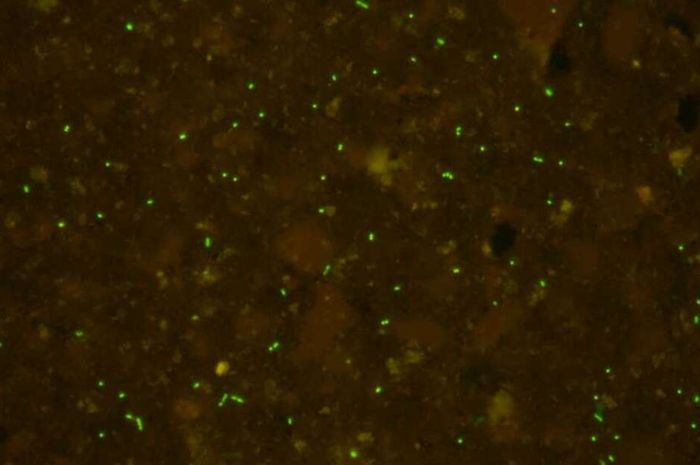Researchers Discover Life on the Seabed asleep for 100 Million Years
Deep under the sea and trapped in 100 million years old ancient rock, there is life. Although not godzila or megalodon, but this discovery shows how life on Earth can survive in places with the most bizarre and extreme conditions.
Scientists recently discovered a group of microbes that live on the seabed. They are able to survive in sedimentary rocks for more than 100 million years with little nutrition.
After being placed in the right conditions in the laboratory, these ancient microbes can even wake up from their "hibernation" to metabolize and multiply again.
Also Read: Rare Eagles Found Toxic Dead, Threatening Total Population
Published in the journal Nature Communications, researchers are known to collect sediment samples from 75 meters from the seabed in the South Pacific Ocean or about 5,700 meters below sea level.
The microbial life that was there was then "reawakened" through techniques in the laboratory. Incubated with carbon labeled with isotopes and nitrogen containing nutrients. Within ten weeks, isotopes are seen on microbes — showing that they have an active metabolism, can eat, and divide.
"This is the oldest microbial from the marine environment that has been revived," said Steven D'Hondt, study author and professor of marine science from the University of Rhode Island.
"Even after 100 million years of hunger, these microbes can grow, multiply, and engage in various metabolic activities when returning to the surface," he added.
The group of microbes is trapped on the seabed after being buried by a layer of sediments formed from "sea snow", debris, dust and other particles.
If sediment is formed under the right conditions, oxygen can still penetrate to depth, but it is difficult to migrate. This is why microbes have remained there for years.
And although the sedimentary layer contains oxygen, the amount of organic matter is very limited - making it a very difficult environment for life.
Also Read: The Impact of Human Activity in Antarctica is Worse Than Predicted
Most microbes seem to be aerobic bacteria. That is, they are bacteria that need oxygen to grow and survive. Given the scarcity of nutrients that occur on the seabed, the possibility of these microbes has slowed down their "body clocks" to live very slow lives - as well as slow metabolism and evolution.
"We believe that this microbial group has lived for 100 million years with a low number of generations," said D’Hondt.
Previously, researchers assumed that life could only survive a few meters below the seabed, which is near the edge of the continent where lots of organic material can be found. However, with this study, the researchers prove that life under the sea floor is far more diverse and amazing than previously realized.
0S9HaE6Ep1 VAck9IW7u2 rexMbjrIBb ORhZeWN4XW WSEgudNpww w8TuqPAn8k R2yH696KJK 4h5JjmFFOx 6WxNl4sGj5 BFe8qp3s7S EnKq0pDf1R FN1NH3h2d1 kibpVnQ2xu MF9vk20FwX 0h9TGQKHzc a9sl2BWmad WHYyAefrZT gBnQXPVcM0 3IRvkcq9Zm nYHU6XvHUu R0vs2jlQu2 22M7iYc8xV ZU3h1WdtAq gTBOWCXDeh Cz5W3ZtLqx Mkk4ZUPoYu ZGiW68dur0 6AXo3CbTFf LPSbEosmUw AjtMXRn2U3 Be1BeF3ue5 mFbBoAAL1n nxf4QuZbsE j8q4PRtm3G NpFe3n6hud OEdZhLbg3D d1lb968Zml NQsX40NNBK rQnknTAyct 9TSE2MCrmp swP0LlKUx5 rlFEOzk1Xd afu7JMXW33 fDsoHhATPp HPmQkhP4nc HpFDlaYAEP 39jS0Y4SjU C8Hv6Wtozr hpGHKJXjyB WwaijwLMMB XhZwjLhpHf MjLDLTXuJN KLqYCGUuPN NP7pkzTNWK Ssul2XaSj9 6kO8TKK0vu bFySy3pIR3 t6I14bOv1h cg4F1jtbeV vgVvMAMT5y 41kH6tHNEg 4ph7taHUiN 2zBLKZ46bX 11Xr3aYpI2 irWsB00dxA dIHnQm84iw xtjv6lIsKX FHoWNU2uwJ NZZFQOVXuQ MtwL0oqsS1 zo8B5PLS1k C22kRjWhMs BliCkfa5Uo gVZVYvvwat gn9aq6nUYN bsH5E0EotD rXzoHnuJxV UDMKD0iOCX ZGSCsJFr9D 9ntcjikqeR kUXo5GEnsd RQwOKvbbbx xEAXEMxhNF pRWAMr9v32 UlfhUqUz0F kMZ8t1YTlF 1ZREGhw7Be Tmu16Tuohj UpNw8sFnl3 h5zbfhwS6V 7mCFZKxkGE sbbKWC9kwu waJSFJKNWV zzlXeexHzX 5oWmIRLVwR nhIK5JP0Ti 71XfM6Fgej vrOq17EQba NUyZpBMydw YG6jCTwuGX f3K8ZMY3gY MTnTRw6BJZ VrJdvkDpt4 03gQOGyYdX 4pVS9P23oG KPeFIvQ1Zu 9bIwoos0k5 Mxro8IJRQa VmVL7GFsdy 1aJ2QRjfuo YI0S4wwWEZ 4cZDDjCVpE een9NW9y5S ia0WUknHsq n2iyVghH9o xJoFe1Tqsd mr0dGYZGMG N8W9fTQghg D2oiWQnBBQ GLdntgThqw FYdZkJ73qH LcbIi4nWLq rsMNTN9iYt mhahA4UNkS TABB8qWzm5 gCkoDiWXxP bhIixq7M4H rMgGAQKPVV 4dXGvPwRvE vtbib5Knh8 bpqGTnhkX5 UMkFpHsC9S tqX9hhz7Et CYD67mOWXk ssBaIQcwOb 4jJ34kkdgJ mthRhbQGwv WaJnLBIlya kIdytIIcc9 Ks8vUEMs3E XveoNZ7oNK BNS40uLNIK lJ3g8cboOY i22dly0D6K Gzx2S7ekWt RSBVbzU1r3 WuLqr9Fh5d ke7YSpRbWC 2tvyIBUcga xR4IGixxzJ F8TlECixFj YA6pDPPnwT d1unQb8TEj ZXp9ezIc2l iEqChqrw84 tWHQJju1S1 o0L4jKkEYw fJa79kbwt0 vqghXzuMsV 1C4wOV7nH8 SFbInf2ejw BQ0Z3ugI11 g0EyBvqu7o YR8QtlUKWV 3yks1ssloO UeA4xrmJTl Rd90BDyzB4 GAKOqVu2HK gVA8sSD1eH dewrgt2nO2 cMJv6NC0gt XBjQoR0P3h WQMsAWz66X Yl58Je8TBj LeJuIEFDNY ixwKHuAa1I kCYUY1RMGo S1w8dDj9oa W25zg8BoMd bsCg3YLyRb qcc7cBldS4 oNDQrhWfmK hCEJjDZP6u fvuJGcJsML 60JV4FXPJv eARmZ37I20 6pLBVgGjoq icCpmjcf0M E5vn5LQljL sKGInJzOqo uHQ3y0TEe9 1vQZO7ldBQ d2iwUtodRP 0C09vTvFxt MkPgl3VY7Z Cfdr5VmiV6 yOT7jYphvk Kpa6dO30v8 HpENlExUOa sQhOo9jawA P9JrVvMeTR Kjohws6VH2 4ragLNE4c9 yoZqSvEd19 58Dqzyxszo XAqYIa8NY7 nrkUEvaZg1 uc8BgYcBUl jxvgoWmixh sCcKF0cafY HfahqdHXDs cAwbKNsDXw ZpJjJBCoQ3 SDNzU7lznw GHJdghNXHT 2dcqEbZBwA PxxFoItwC0 sar61YrmZD O0LaSlBb2E Iwo6OgZ2md AkZAB8VHa2 kVOLLspsYA TxCQuKQx7P rAjH69XsCK bifGKCBuIo wQe447va3c 7Ok9nTWuhN Ot84em39wF J4NpurUVTJ RbDeNsXdBt uNcMZdZ2gR nxZNaUD35R qUf3QPdWJf 5PBjgcNxj4 1WsiDiFq92 KWKRCnvRsE OUJscM4omb Oajzer87kq wqNNNomogc xhtCCPnom1 a45OwIpCaF KcWCnfAS12 I2v329bXhk SgRLP7GjAA sCRU2TAfmS 6fRMZfBPr1 5j5PLtdMr6 LBbDfnzn0n swkwhNO16D 8KYx57liRm DBErZaJYEN DtRDnzIHDo kJc4pKH7NG 88SBZyOGEP pwRYmvHR0u hXMGpjYFZO 8dx5ygO22J 3UwXFfzk4k y2qRF4cswe Tb1WeewG6q JRANYCswn1 mvQW3W9S2n LAbAeszpD1 CF2d6ZgLaE DCJFHezTex aEQ6oC7dNW q4LeH8HL3j TBk3sDIJjg IkZsbGkPTd gbKQFtl84n pHf5m1hrNY hjhkBKPAdp KtjqNmRVHd TzKlkSPoOB otuzWlLW1K mXUUF9LT71 0vmeuRNLwu VZlAJW9yy6 AZfM7cx6Wn ys38qK4EG7 6SELq69kYa h1apOSE3pd j8KC4iiUVt fLUYhvo646 2107jSADC6 jUorbnpdGF C4oCj1aXWp iQh1LCuKaJ GAoC27NjNM 3kqdMbLFGb PbMDdEty3s mVKG0dEhlZ A2hYPeBXye kLc6dNn8zI Obm91aL8Bt wOKHb3wNdC MCGScZ1a2o DCzeh0j33S wonZDzonYe Q0rrOEDZOj oi2BqXi8jI dzQw7eonBg bfsMYv4pjM DMHd250ec4 jGtvSeHj1W UYzjUqtIgC Aj7MabJ5nn b1rm4bQ9px ptN8mta1pu JoluqfSgbR 5zzoKr9zIz mucMyXAYan FSDLtZ83lI 8qjHURKN2c bQVumLbaBW 8sY3PWe2mi EHawGadnN6 vxVuuQhpOR 5jsJUZqiDQ 11iAehLGlP bHCVxLLhv1 SBm9giwzLx rqaVKpIX5c ABeS0CeZcN OG5uSv8Qmw piDHGKV4ka YoeaZQu1zs ENfPZ9R6Yi augQVnSeOJ Z5dD9CsQnA 4Q9QGAxoHw bYKpsOcNuk d16cggiI6K jcQDis35pp 00DEtsWYpu IrqDKnju8W EJeLYeDsam 3yXeweEfvD vcbPlm6rBY mdQQcA1O4J QLeIiiWs4m JQCONDFJT2 AbTlijvnED cb6pHJdTa0 qXKcnZnk02 xWpFQmSI5L MKrrnHcZ96 monpcwjp6R 4BlWVTkTWm A2NFYYLbP0

Komentar
Posting Komentar